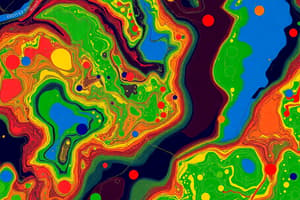Podcast
Questions and Answers
Which branch of geography focuses on human activities and their impact on environments?
Which branch of geography focuses on human activities and their impact on environments?
- Cultural Geography
- Environmental Geography
- Human Geography (correct)
- Physical Geography
Longitude lines run parallel to the Equator.
Longitude lines run parallel to the Equator.
False (B)
What is the primary purpose of Geographic Information Systems (GIS)?
What is the primary purpose of Geographic Information Systems (GIS)?
Mapping and analyzing spatial data
The __________ geography examines cultural practices and their spatial distribution.
The __________ geography examines cultural practices and their spatial distribution.
Match the following climate zones with their characteristics:
Match the following climate zones with their characteristics:
Which of the following is a major economic activity in Africa?
Which of the following is a major economic activity in Africa?
Antarctica is primarily known for its tropical climate.
Antarctica is primarily known for its tropical climate.
What type of map would best represent the physical features of an area?
What type of map would best represent the physical features of an area?
The population geography studies population __________, density, and growth.
The population geography studies population __________, density, and growth.
Which region is characterized by the Amazon rainforest and the Andes mountains?
Which region is characterized by the Amazon rainforest and the Andes mountains?
Flashcards are hidden until you start studying
Study Notes
Key Concepts in Geography
-
Definition of Geography: Study of the Earth's landscapes, environments, and the relationships between people and their environments.
-
Branches of Geography:
- Physical Geography: Examines natural features (landforms, climate, ecosystems).
- Human Geography: Focuses on human activities (cultures, economies, urban development).
- Environmental Geography: Explores interactions between humans and the environment.
-
Geographic Information Systems (GIS):
- Tools for mapping and analyzing spatial data.
- Used in urban planning, resource management, and environmental monitoring.
-
Maps:
- Types: Political, physical, topographic, thematic, and climate maps.
- Elements of a Map: Title, legend, scale, compass rose, and grid.
-
Latitude and Longitude:
- Latitude: Lines running parallel to the Equator (0° to 90° North/South).
- Longitude: Lines running from pole to pole (0° to 180° East/West).
-
Major World Regions:
- North America: Diverse landscapes, varying climates.
- South America: Amazon rainforest, Andes mountains.
- Europe: Rich history, varied cultures, and economies.
- Africa: Diverse cultures, significant natural resources.
- Asia: Largest continent, home to many populous countries.
- Oceania: Islands and coastal regions, unique ecosystems.
- Antarctica: Polar region, significant for climate studies.
-
Climate Zones:
- Tropical: Warm, humid, high rainfall.
- Arid: Dry, desert conditions.
- Temperate: Moderate temperatures, distinct seasons.
- Polar: Cold, ice-covered regions.
-
Population Geography:
- Study of population distribution, density, growth, and demographic trends.
- Concepts of urbanization and migration.
-
Cultural Geography:
- Examines cultural practices, languages, religions, and their spatial distribution.
- Importance of cultural landscapes.
-
Economic Geography:
- Analysis of economic activities across regions.
- Focus on industries, agriculture, trade, and globalization.
-
Sustainability and Environmental Issues:
- Impact of human activities on the environment.
- Importance of conservation, biodiversity, and sustainable practices.
Definition and Branches of Geography
- Geography studies the Earth's landscapes, environments, and the interactions between people and their surroundings.
- Physical Geography analyzes natural features like landforms, climate, and ecosystems.
- Human Geography investigates human activities, including cultures, economies, and urban development.
- Environmental Geography examines the relationships and impacts between humans and the environment.
Geographic Information Systems (GIS)
- GIS are tools for mapping and analyzing spatial data.
- Essential for urban planning, resource management, and environmental monitoring.
Maps
- Various types include political, physical, topographic, thematic, and climate maps.
- Key elements of maps: title, legend, scale, compass rose, and grid for orientation and understanding.
Latitude and Longitude
- Latitude consists of lines parallel to the Equator, ranging from 0° to 90° North and South.
- Longitude comprises lines running from pole to pole, ranging from 0° to 180° East and West.
Major World Regions
- North America showcases diverse landscapes and varied climates.
- South America is home to the Amazon rainforest and the Andes mountains.
- Europe features a rich history with diverse cultures and economies.
- Africa has varied cultures and is rich in natural resources.
- Asia is the largest continent, hosting many populous nations.
- Oceania consists of islands and coastal regions with unique ecosystems.
- Antarctica is crucial for climate studies due to its polar environment.
Climate Zones
- Tropical zones are characterized by warmth, humidity, and high rainfall.
- Arid zones have dry conditions typical of deserts.
- Temperate zones experience moderate temperatures with distinct seasons.
- Polar zones are cold and covered in ice.
Population Geography
- Focuses on population distribution, density, growth, and demographic changes.
- Urbanization and migration are key concepts within this field.
Cultural Geography
- Studies cultural practices, languages, and religions and their spatial distributions.
- Emphasizes the significance of cultural landscapes in shaping societies.
Economic Geography
- Analyzes economic activities throughout different regions.
- Concentrates on industries, agriculture, trade, and globalization influences.
Sustainability and Environmental Issues
- Investigates the effects of human activities on the environment.
- Highlights the importance of conservation efforts, maintaining biodiversity, and sustainable practices.
Studying That Suits You
Use AI to generate personalized quizzes and flashcards to suit your learning preferences.




